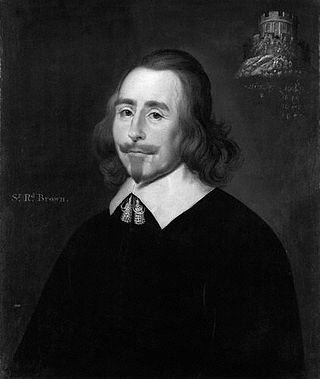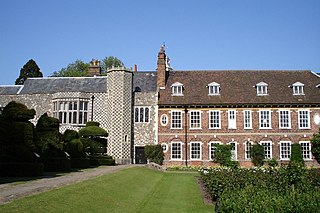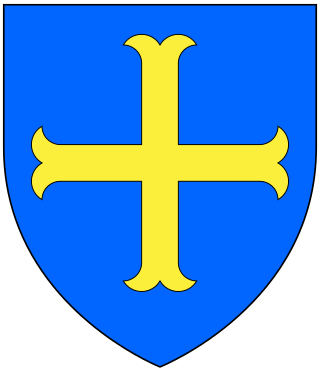Related Research Articles
Baron Athlumney, of Somerville and Dollarstown in the County of Meath, was a title in the Peerage of Ireland. It was created in 1863 for the Liberal politician Sir William Meredyth Somerville, 5th Baronet, who had previously served as Chief Secretary for Ireland. In 1866 he was also created Baron Meredyth, of Dollardstown in the County of Meath, in the Peerage of the United Kingdom. He was succeeded by his eldest and only surviving son from his second marriage, the second Baron. He was childless and on his death in 1929 the baronies became extinct while the baronetcy became dormant.

There have been ten baronetcies created for persons with the surname Browne, six in the Baronetage of Great Britain, three in the Baronetage of Ireland and one in the Baronetage of Nova Scotia. Only one creation is extant as of 2010. Three of the creations were for members of the Browne family headed by the Viscount Montagu.

There have been six baronetcies created for persons with the surname Smyth, two in the Baronetage of England, one in the Baronetage of Great Britain, one in the Baronetage of Ireland and two in the Baronetage of the United Kingdom. One creation is extant as of 2010.

Three baronetcies have been created in the Baronetage of England for members of the Littleton or Lyttelton family. All three lines are descended from Thomas de Littleton, a noted 15th-century jurist. Despite differences in the spelling of the title, the names of all three lines were spelt in many varied ways in the early modern period, without distinction between the different branches of the family. This can be confusing, as the range of forenames in use was very limited.
Nineteen baronetcies have been created for persons with the surname Hamilton, eight in the Baronetage of Nova Scotia, one in the Baronetage of England, five in the Baronetage of Ireland, one in the Baronetage of Great Britain and four in the Baronetage of the United Kingdom. As of 2008 two creations are extant, two are dormant, two are either extinct or dormant and twelve extinct.

There have been two Baronetcies created for persons with the surname Austen, one in the Baronetage of England and one in the Baronetage of Great Britain. Both creations are extinct.

The Chaytor family is an English gentry family on which has been conferred two baronetcies, one in the Baronetage of England and one in the Baronetage of the United Kingdom and several knighthoods. As of 2008 one baronetcy is extinct.

There have been twenty one baronetcies created for persons with the surname Williams, eight in the Baronetage of England, three in the Baronetage of Great Britain and ten in the Baronetage of the United Kingdom. Only six of the creations are extant as of 2017.
There have been three baronetcies created for persons with the surname Everard, one in the Baronetage of Ireland, one in the Baronetage of England and one in the Baronetage of the United Kingdom. Only one creation is extant as of 2010.

There have been three Baronetcies created for persons with the surname Seymour, two in the Baronetage of England and one in the Baronetage of the United Kingdom. One creation is extant as of 2008.
There have been five baronetcies created for members of Clan Ramsay, four in the Baronetage of Nova Scotia and one in the Baronetage of the United Kingdom. The baronetcy in the Baronetage of the United Kingdom is extant as of 2023.

There have been six baronetcies created for members of the Corbet family, four in the Baronetage of England, one in the Baronetage of Great Britain and one in the Baronetage of the United Kingdom. All creations are extinct. The recipients were descendants of the ancient Norman family of Corbet which held substantial estates in Shropshire including Wattlesborough, Caus Castle, Moreton Corbet Castle and Acton Reynald Hall.

There have been three baronetcies created for descendants of the ancient Norman family of Molyneux who were granted extensive estates in Lancashire after the Norman Conquest.

There have been three baronetcies created for members of the Sedley family of Kent, all in the Baronetage of England. All three creations are extinct.

There have been five baronetcies created for members of the old established family of Peyton of Peyton Hall in the parish of Boxford in Suffolk, all of whom were descended from Sir Robert Peyton of Isleham in Cambridgeshire, grandson and heir of Thomas Peyton (1418–1484) of Isleham, twice Sheriff of Cambridgeshire and Huntingdonshire, in 1443 and 1453. All the baronetcies are extinct.
Richard Meredith was the Church of Ireland Bishop of Leighlin from 1589 until his death.
The High Sheriff of Meath was the British Crown's judicial representative in County Meath, Ireland, from the conquest until 1922, when the office was abolished in the new Free State and replaced by the office of Meath County Sheriff.

There have been three baronetcies created for persons with the surname Meredith, one in the Baronetage of England, one in the Baronetage of Nova Scotia and one in the Baronetage of the United Kingdom. Two of the creations are extinct while one is dormant.
The Brabazon Baronetcy, of Newpark in the County of Mayo, was a title in the Baronetage of Ireland. It was created on 16 December 1797 for Anthony Brabazon. He was the eldest son and heir of George Brabazon, of New Park in County Mayo, fourth in descent from Sir Anthony Brabazon of Ballinasloe Castle, younger brother of Edward Brabazon, 1st Baron Ardee, ancestor of the Earls of Meath. His son, the second Baronet, represented County Mayo in Parliament. The title became extinct on his death in 1840. Brabazon Park was eventually inherited by Hugh Brabazon Higgins, only son of Luke Higgins of Castlebar by his second wife Catherine, sister of Sir Anthony Brabazon. He was a Captain in the 15th Hussars, and adopted the surname of Brabazon by royal licence of 15 September 1852. He died in 1864, leaving issue.
The Meredyth family were an Anglo-Irish family descending from Richard Meredith, a Welsh clergyman who went to Ireland in 1584 and became Bishop of Leighlin.
References
- 1 2 3 Sidney Lee ed., Dictionary of National Biography , vol. XXXVII (1894) pp. 270–271.
- 1 2 3 G. E. C., The Complete Baronetage, vol. III (1903) p. 306.
- ↑ Edith Mary Johnston-Liik, The History of the Irish Parliament 1692–1800, vol. V (2002) pp. 243–244.
- 1 2 History of the Irish Parliament, vol. V, pp. 246–247.
- ↑ History of the Irish Parliament, vol. V, p. 244.
- ↑ History of the Irish Parliament, vol. V, pp. 242–243.
- ↑ History of the Irish Parliament, vol. V, pp. 244–245.
- ↑ History of the Irish Parliament, vol. V, p. 248.
- ↑ History of the Irish Parliament, vol. V, p. 247.
- 1 2 3 4 5 6 7 The Complete Baronetage, vol. III, p. 307.
- 1 2 3 4 5 6 The Complete Baronetage, vol. V (1906) p. 436.
- ↑ History of the Irish Parliament, vol. V, pp. 245–246.
- ↑ History of the Irish Parliament, vol. V, p. 243.
- ↑ The Complete Baronetage, vol. III, pp. 306–307.
- ↑ The Complete Baronetage, vol. V, p. 424.
- 1 2 The Complete Baronetage, vol. V, p. 358.
- ↑ Who Was Who , vol. I, p. 488.
- ↑ Who Was Who, vol. III, p. 43.
- ↑ The Complete Baronetage, vol. V, pp. 436–437.
- ↑ Who Was Who, vol. II, p. 724.